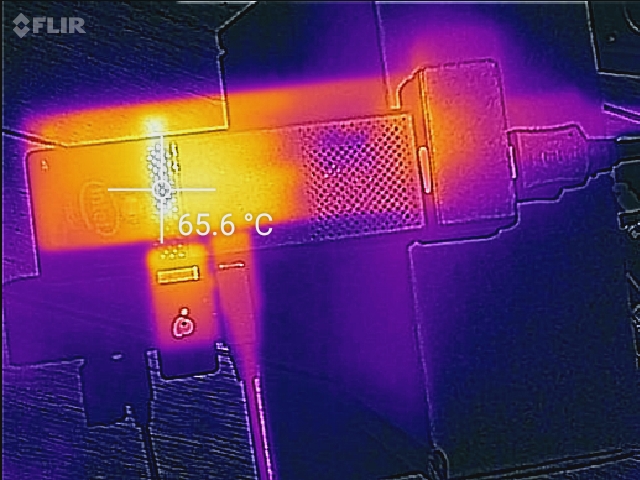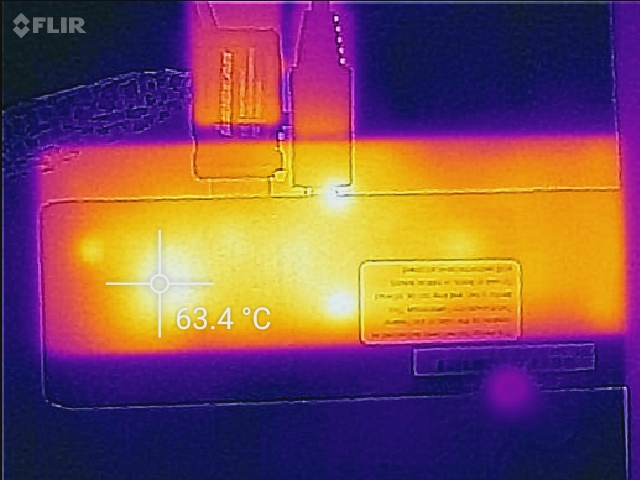The Intel Compute Stick (Cherry Trail) Review
by Ganesh T S on January 14, 2016 8:00 AM EST- Posted in
- Systems
- Intel
- Cherry Trail
- HDMI Stick
- CES 2016
- Compute Stick
Power Consumption and Thermal Performance
The power consumption at the wall was measured with a 1080p display being driven through the HDMI port. In the graphs below, we compare the idle and load power of the Intel PPSTK1AW32SC with other low power PCs evaluated before. For load power consumption, we ran Furmark 1.15.0 and Prime95 v28.7 (32-bit) together.


Compared to the Bay Trail Compute Stick, the Cherry Trail one has higher idle and load power consumption numbers. Given the upgraded Wi-Fi, the idle number can probably be justified. The load number is more due to the upgraded GPU which delivers much better performance while also consuming as much power as possible while staying within the acceptable thermal envelope.
Our thermal stress routine starts with the system at idle, followed by 30 minutes of pure CPU loading. This is followed by another 30 minutes of both CPU and GPU being loaded simultaneously. After this, the CPU load gets removed, allowing the GPU to be loaded alone for another 30 minutes. The various clocks in the system as well as the temperatures within the unit are presented below.
According to the official specifications, the junction temperature of the Atom x5-Z8300 is 90 C. The thermal solution is able to keep all temperatures around the 80C mark without excessive throttling. In the absence of any GPU loading, the CPU cores maintain a 1.6 GHz speed. We didn't observe the cores operating at the maximum burst frequency at all (1.84 GHz). With GPU loading into the picture, the cores can drop down to as low as 900 MHz even with the CPU load active. The GPU shunts between 380 MHz and 500 MHz depending on the load and available thermal headroom. One disappointing aspect is that the idling temperature of 57 C for the CPU cores is a lot higher than what we would like.
Using the Android version of the FLIR One thermal imager, we observed the chassis temperature after the CPU package temperature reached the steady state value in the above graph.
We see that the chassis remains below 66 C even when the internal SoC is at 80 C.














80 Comments
View All Comments
mabsark - Thursday, January 14, 2016 - link
I'm got a Brix 1900 mini PC which I use as a HTPC / Plex Media Server. It's got 4 GB of RAM and a 30 GB SSD. It runs Windows 10, Kodi and Plex Media Server. There's still about 6 GB free. All the media is stored on my NAS so the HTPC doesn't need more storage.Compute Sticks are basically streaming devices. You're not going to be installing a load of apps or media on them so they don't really need much storage space.
BrokenCrayons - Friday, January 15, 2016 - link
You do have a good argument, but my days of running in home servers and/or NAS units are long over. I don't want to deal with the hassle of being a systems administrator for my spouse and kids when all I really want my computers to do are provide connectivity, data processing, and entertainment at minimal operating overhead (power, space, heat & cooling, and time invested). That means ANY computer coming in the door needs to meet a certain set of criteria in painlessness of operation. 32GB of storage on a Windows box creates more problems than it solves and makes the Compute Stick a poor general purpose computing device. In my case, I don't deal with streaming media much except for the occasional YouTube clip or an Amazon video rental so the "everything else" a Compute Stick can do (or any other computer for that matter) is far more important than video playback and those other purposes do require a little more flash and, ideally, a couple more gigabytes of RAM.mabsark - Friday, January 15, 2016 - link
Beyond media and web browsing, what else would you be doing on such a weak system? If you need the functionality of a proper PC then you buy a proper PC, not something like a compute stick.The same applies to your HP Stream 11 which is clearly billed as a "cloud computer". Basically, you're looking at the wrong type of products for your needs and then complaining that they're not good enough. You may as well be complaining that it's unable to run the latest AA games at 4K.
BrokenCrayons - Friday, January 15, 2016 - link
My TRS-80 packing a 1.7MHz Zilog Z80 could play games and run a word processor without storage capacity problems. I don't see why 35 years later, a budget PC with a general purpose x86 processor shouldn't be expected to do much, much better. Besides that, the price difference between 32 and 64GB of solid state memory is insignificant, even given the relative cost of the rest of the platform. It's a perfectly valid complaint.Reflex - Friday, January 15, 2016 - link
A budget PC nowadays does much, much more than your TRS-80 ever did. Granted, more is better, but the comparison you are making is ridiculous.Lord of the Bored - Saturday, January 16, 2016 - link
Man, I'm still fighting to get the "instant-on" of my old 99/4a on a modern system. But at least boot times are starting to come back down. That's progress!doggface - Tuesday, January 19, 2016 - link
this argument is the worst. You could probably still play those games, and they would work a lot better. but not new games. and i bet your TRS-80 cost a bit more than $200 too.Completely different device. If you are looking to do anything more strenuous than basic internet or streaming.. you are barking up the wrong tree.
BrokenCrayons - Thursday, January 21, 2016 - link
"Completely different device. If you are looking to do anything more strenuous than basic internet or streaming.. you are barking up the wrong tree"That makes no sense at all to me. Cherry Trail systems have vastly more compute power than systems of not so long ago that were fully functional computers (ala 100MHz Pentiums, and TRS-80s). Given their immense computational capacity, there's no reason at all to intentionally limit the usage of such hardware to only a small subset of tasks billions of computers that came before it did perfectly fine with far more limited resources. It's a desktop PC in a small case and therefore it should be accordingly expected to handle any and all desktop PC chores a user requires so they don't need to waste money/time/space/effort buying a Compute Stick only to have to purchase an additional computer in one of many absurdly large, obsolete ATX-derived form factors.
Gunbuster - Thursday, January 14, 2016 - link
Does this work on a 4K TV at 4K resolution? Pretty much useless if it doesn't IMHO...dsraa - Thursday, January 14, 2016 - link
That's not what it's designed for.....